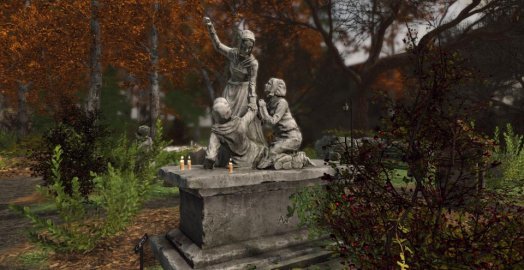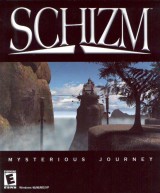Review for Nancy Drew: Midnight in Salem

By 1998, the golden age of adventure games was largely over, but that didn’t stop fledgling developer HeR Interactive from releasing their first Nancy Drew mystery game, Secrets Can Kill. Between then and 2015, the company would go on to release 32 entries in total, but then came the announcement that HeR was looking to move from their old pre-rendered slideshow presentation to real-time 3D for the next installment, Midnight in Salem. And then…nothing. After regularly releasing two games per year for well over a decade, it would turn out to be four full years before the new adventure was done. But now the long-delayed Midnight in Salem is finally here, and with it comes a new format more focused on character and plot than puzzles, featuring almost casual levels of gameplay. It’s great to see Nancy back in action again, although the results are something of a mixed bag even after such a long wait.
The game begins with a brief tutorial section taking place in Moosham Castle in Austria. Nancy’s father has sent his titian-haired detective daughter to help track down the Book of Apologies, a ledger detailing all the people who were wrongfully accused of witchcraft in the Salem Witch Trials of the 17th century. The book is to be taken to Salem, Massachusetts and delivered to one Judge Danforth to help compensate the descendants of the unjustly accused. This short section reveals much of what is both old and new with this latest installment in the Nancy Drew series.
Midnight in Salem has indeed made the jump to real-time 3D, but it still retains the node-based movement of its predecessors instead of allowing for free roaming about the environment. Within a given station, the game operates more or less like a typical first-person point-and-click game. Moving the mouse about the scene causes the pointer to change when over something interesting, whether the path to the next location, an item or area that can be examined more closely, or a device that can be manipulated. Clicking on the left or right side of the screen rotates the camera 90 degrees and clicking on the bottom of the screen turns you completely around to face the other way. However, turning can be a bit more complicated than it sounds.
Along with rotating in predetermined increments, it’s also possible to look around within any given view. By holding down the right mouse button and dragging, you will be able to look up and down and also pan partially left and right, though never the full 90 degrees in either direction you get by clicking the screen edges. So, for example, if you’re facing north, you’ll be able to freely turn to look northwest or northeast, but not all the way to the west or east. Compared to other node-based adventures in which each scene is essentially a sphere that allows players to freely spin in place, Midnight in Salem's system is more restrictive and proves to be a little cumbersome.
Beyond basic movement, Nancy also has an inventory at the bottom of the screen where she can collect a few items throughout the course of her adventure. A nice touch is that any such object can be inspected up close and rotated in three dimensions. In a couple of cases this sometimes yields additional hotspots, such as finding a business card in a jacket pocket. I found myself wishing this element would have been used more as it felt quite investigative to me.
In short order, Nancy discovers the lost book she’s searching for before she’s momentarily distracted by a cell phone call from frenemy Deirdre Shannon. Deirdre reports that she’s in Salem herself, where her young cousin Mei Parry has been accused of burning down the historical Hathorne House. While chatting, the momentary distraction of Nancy allows a hooded thief to break into the room and escape with the book. Sensing a connection between the book and the fire, Nancy heads for Massachusetts where the story proper begins.
Previous Nancy Drew games tended to place a strong emphasis on solving mechanical puzzles, codes, ciphers, and the like rather than on detective work. Midnight in Salem significantly switches that focus to its characters, story, and various mysteries that crop up as Nancy pokes into events. Most of your time is spent visiting nearly a dozen suspects and speaking with them via dialog trees. These conversations tend to be of a grindy nature, where every available option must be chosen in order to progress. Occasionally there are some light choices to be made that affect how characters feel towards Nancy at the end of the game, as well as who’s around to congratulate her on a job well done.
Fortunately the varied cast is quite interesting, which (mostly) keeps the rather lengthy exchanges from seeming unwieldy. Mei is a sullen teenager who keeps burn scars from her childhood covered by her clothes and hair, and who hasn’t provided an alibi for reasons of her own. Her sister Teegan runs the local museum, is passionate about the history of the town, and has founded the Accused Witches society to seek reparations for those who were wronged. Meanwhile, the theatrical Olivia Ravencroft is looking to make a buck off the tourists by playing up the region’s witchcraft history. And local shopkeeper Lauren Holt, who was living in a guest house on the Hathorne estate, just wants to keep her home. Through the course of the story, these suspects and more all have reason to be seen as suspicious, even as further intrigue regarding the lineage of the residents of Salem, historical land grabs, and the possible presence of supernatural forces add additional layers to the mystery.
It’s a lot for one young sleuth to deal with, and after Nancy encounters an angry spirit in the woods one dark and rainy eve, she calls in the cavalry. No, not longtime friends Bess and George (who aren’t included at all this time) but rather those other teen detectives, the Hardy Boys. Frank and Joe show up to help with the investigation and Frank even becomes a playable character for a couple of short segments, though the switch in protagonists doesn’t change the gameplay in any way. The Hardys fare worse in the characterization department than the other people in Salem. Joe is a little too eager to believe in the supernatural (and by a little, I mean a lot), while Frank clearly hasn’t been getting enough sleep as he seems to always be a step or two behind everyone else.
Between long conversations with suspects there are surprisingly few activities to perform. Most of the puzzles are solved by brute force, either because they must, such as matching several wave patterns using Joe’s homemade ghost detector, or because they’re just easier to achieve that way than reasoning them out, like when an icosahedron-shaped 3D key needs to be reassembled from various pieces. There are a few other standalone puzzles, like piecing together a torn note, cracking a coded message, and assembling a timeline from various CCTV recordings, but none of them are particularly challenging. In theory the game can be made harder by choosing the Master Sleuth difficulty over Amateur Sleuth when first starting, but as far as I could tell this only affects three puzzles in the entire game, and oddly, one involving the reconstruction of a chest of drawers was actually much simpler on the Master Sleuth setting.
With very little challenge from the puzzles and more time spent just talking to people, this latest Nancy Drew incarnation is much easier than previous offerings. There’s never any need to record copious amounts of notes, although Nancy does keep a basic To Do list in her phone. Rarely are there more than two or three avenues to follow up on at any given time. On top of that, most key locations are immediately accessible from Salem’s main square, requiring less tedious backtracking than in earlier games, which I appreciated. Between fewer and easier things to do and the consolidation of locations, the end result is a much more streamlined experience than before.
In addition to pulling back on the puzzles, Midnight in Salem also minimizes the amount of educational content. Earlier Nancy Drew games sometimes bordered on edutainment products by providing so much research information about esoteric topics. While this game uses the infamous real witch trials as a backdrop, and even features a museum that is ostensibly devoted to the same, very little information about the historical times is presented and what is here isn’t used to solve the mystery or puzzles in any way. Series fans looking for that extra learning component once again are not really going to find it this time around.
During the game’s extended development, much was made of the series switching to the Unity engine, and where environments are concerned this has been a plus. It’s nice to see Nancy’s world in hi-res and the locations are quite well-detailed. There is usually something going on in the background to add life to each scene, whether it's rain dripping down, autumn leaves falling, or spooky fog creeping through the forest. Even the viewpoint slowly bobs and cants while standing idly to keep things very subtly moving, though never in a distracting way. Despite being limited to Salem and its immediate surroundings after the tutorial section in Austria, the investigation covers several distinct areas including the town square, the nearby cemetery, the courthouse, various homes and shops, and a series of subterranean tunnels. As the story is set close to Halloween, jack-o-lanterns, ghost-shaped scarecrows and the like help to fill in the environs.
Characters are more hit-or-miss visually. For the most part the models themselves do their job of depicting the different suspects distinctively, although some of them suffer from slight proportion issues (many of the characters have large man hands, including some of the women). Teegan Parry and Judge Danforth could have used more work as they just look odd, but others like Olivia, with her open stance and almost renaissance wardrobe, and Deirdre, with her haughty gaze and stay-out-of-my-personal-space rigidness, manage to project a lot of their attitude just through their appearance.
The big detractor for the characters is how they’re animated. Although the occasional animation is excellent, such as when the hooded thief drops a smoke bomb, others are really janky and jarring. Several people perform an arm-swooping gesture that seems a bit like watching C-3PO try to keep his balance when slipping on ice, and Joe’s idle standing animation makes it look like he really needs to go to the bathroom. Lip sync too is all over the place; some is bang on while other lines are in badly-dubbed Godzilla movie territory. Unfortunately these issues are very much on display given how long you'll spend talking in this game.
While the animations aren’t up to the task, the voice talent certainly is, with no weak performances in the bunch. The titular character may face some resistance from longtime fans, as HeR Interactive chose to change from their previous actress Lani Minella to newcomer Brittany Cox. Getting used to one voice across 32 games can make it hard to accept someone new, even after such a long hiatus. But I really appreciated Ms. Cox, as she sounds much closer to what I’ve personally imagined Nancy sounding like when reading the books. I particularly enjoyed how the eternally enthusiastic optimism of this Nancy plays against the acerbic-ness of Deirdre Shannon, who at various points serves as Nancy’s sidekick/partner. Having her tag along works well as it gives Nancy someone to hash things out with, beyond just thinking through the investigation to herself. Even so, it can be a bit startling to turn around somewhere and suddenly find Deirdre standing right there (shades of “creepy Watson” from the earlier Frogwares Sherlock Holmes games).
The rest of the soundscape is filled with a good mix of environmental effects. From spooky wind in the woods to the chants of protestors outside the courthouse, the audio does a lot to help sell the different settings. Nancy’s investigation is also accompanied by background music on very short loops that can best be described as mysterious with varying levels of intensity depending on if you’re just walking around or solving one of the few puzzles in the game.
One element HeR chose to keep from the earlier titles is the possibility of failure or death. There are a few places where the wrong moves can result in a game-over scene, although they’re always well signposted. A couple of light timed sequences also make appearances, although I didn’t find the time limits to be overly onerous. Failing in any of these sections presents a button to immediately try again from before things went wrong. In case that’s not enough, this game is also generous on the saving front. Not only does it provide an automatic progressive autosave that kicks in whenever changing environments or after achieving some significant progress, it also features a full and blessed manual save option. Other developers, take note: this is how to do saving!
Nancy Drew: Mdinight in Salem has a lot of rough edges, especially for a game that’s been in some stage of development for four years. Its character animations and lip sync can be quite off-putting, its node-based movement retains the awkwardness common to all such navigation, and what few puzzles it has are hardly challenging, even on the harder difficulty setting. Yet for all that, the charm of its characters and the intrigue of its story manage to buoy the experience up, if not to the heights of the better games that came before it. The scaled-back gameplay may disappoint longtime series fans, and the change of voice actress for the main character may take getting used to no matter how good she is, but for those looking for a light entry into the world of the Nancy Drew games, Midnight in Salem should be just what the witch doctor ordered.
































